New Product Development Strategies
VerifiedAdded on 2023/03/17
|17
|5270
|23
AI Summary
This article discusses the process of new product development and the factors that affect it. It explores market-related factors, product-related factors, and technological advancements. It also provides insights into pricing strategies and marketing activities. The case study focuses on Huawei Technologies Co. Ltd.
Contribute Materials
Your contribution can guide someone’s learning journey. Share your
documents today.
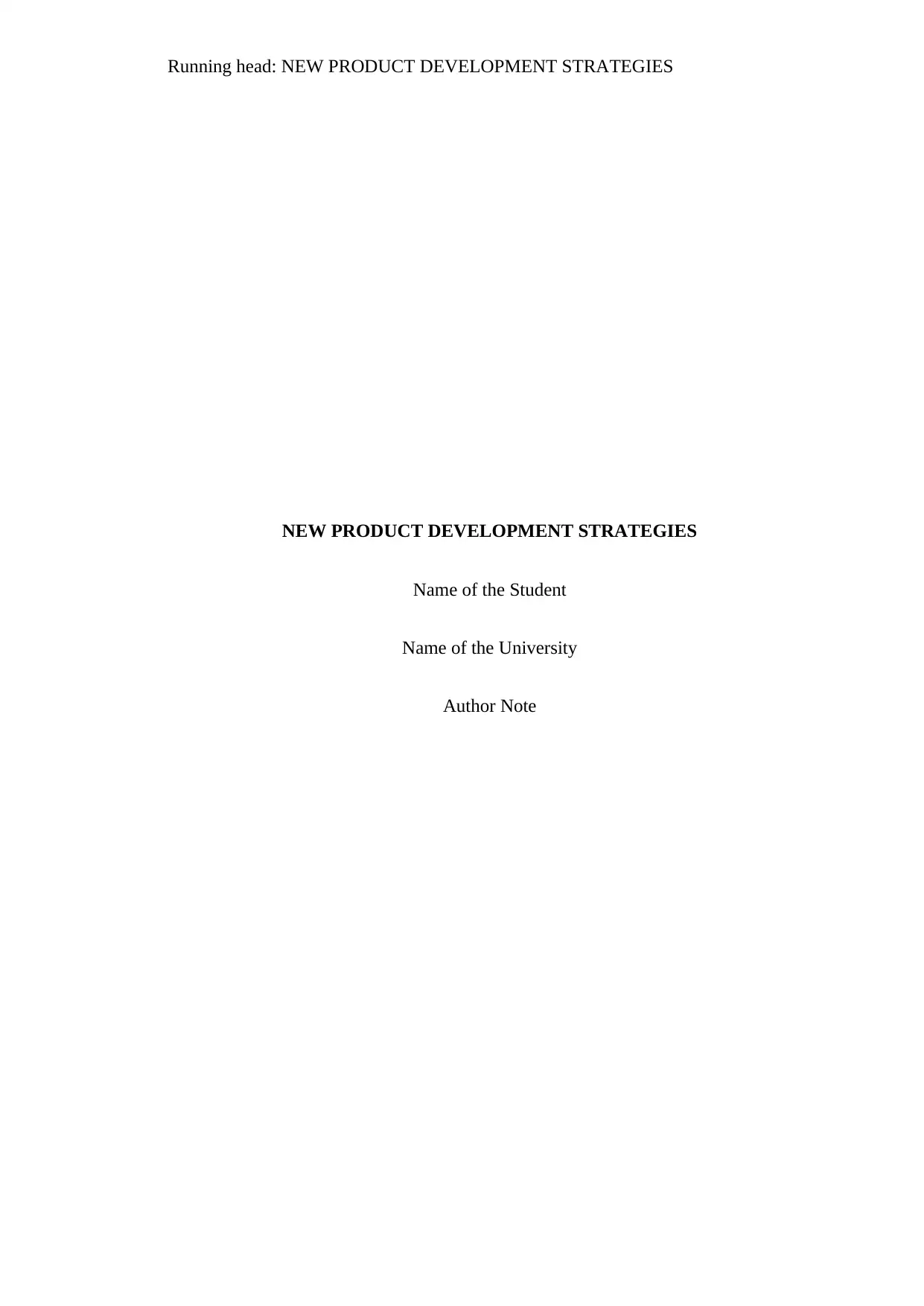
Running head: NEW PRODUCT DEVELOPMENT STRATEGIES
NEW PRODUCT DEVELOPMENT STRATEGIES
Name of the Student
Name of the University
Author Note
NEW PRODUCT DEVELOPMENT STRATEGIES
Name of the Student
Name of the University
Author Note
Secure Best Marks with AI Grader
Need help grading? Try our AI Grader for instant feedback on your assignments.
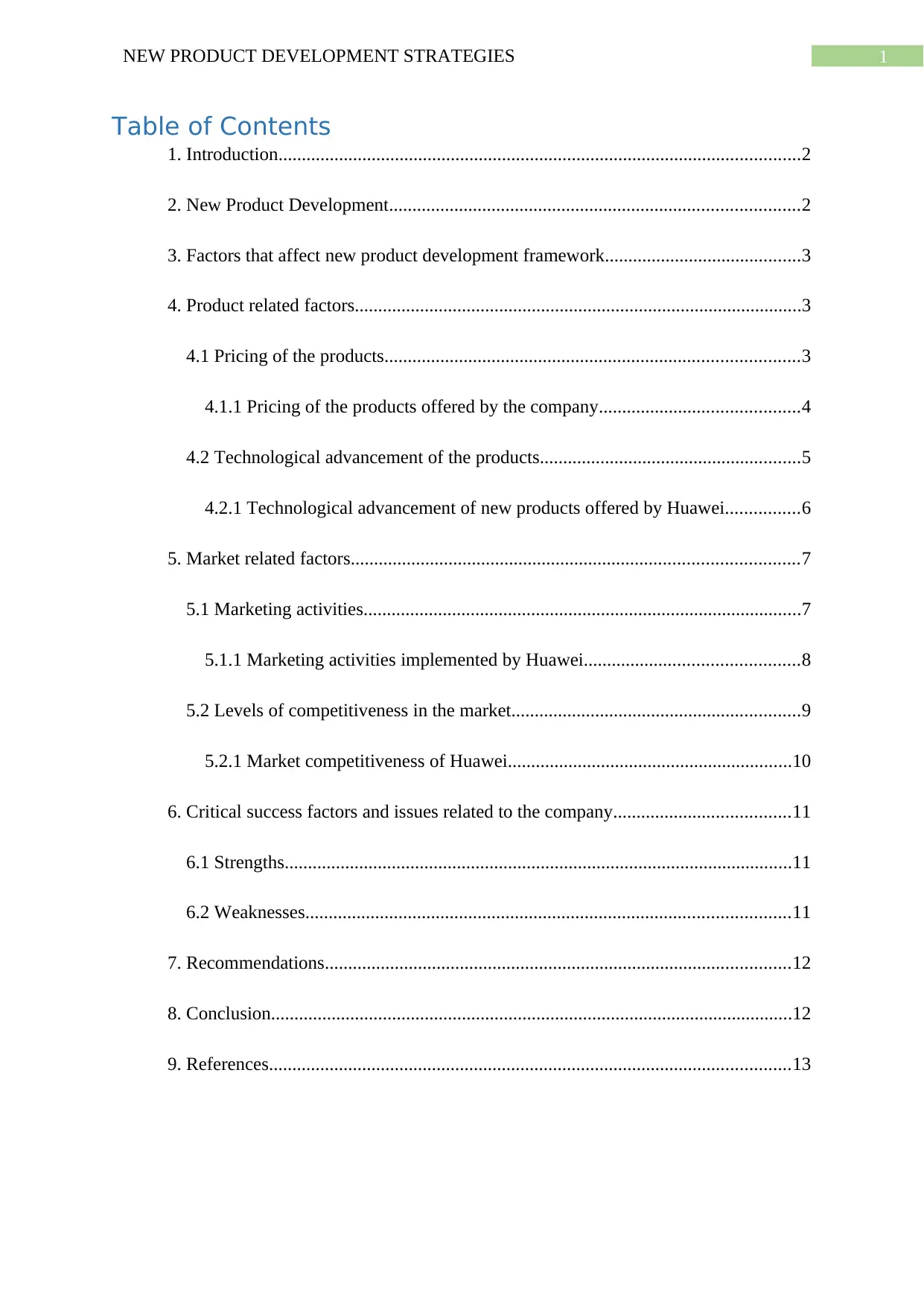
1NEW PRODUCT DEVELOPMENT STRATEGIES
Table of Contents
1. Introduction................................................................................................................2
2. New Product Development........................................................................................2
3. Factors that affect new product development framework..........................................3
4. Product related factors................................................................................................3
4.1 Pricing of the products.........................................................................................3
4.1.1 Pricing of the products offered by the company...........................................4
4.2 Technological advancement of the products........................................................5
4.2.1 Technological advancement of new products offered by Huawei................6
5. Market related factors................................................................................................7
5.1 Marketing activities..............................................................................................7
5.1.1 Marketing activities implemented by Huawei..............................................8
5.2 Levels of competitiveness in the market..............................................................9
5.2.1 Market competitiveness of Huawei.............................................................10
6. Critical success factors and issues related to the company......................................11
6.1 Strengths.............................................................................................................11
6.2 Weaknesses........................................................................................................11
7. Recommendations....................................................................................................12
8. Conclusion................................................................................................................12
9. References................................................................................................................13
Table of Contents
1. Introduction................................................................................................................2
2. New Product Development........................................................................................2
3. Factors that affect new product development framework..........................................3
4. Product related factors................................................................................................3
4.1 Pricing of the products.........................................................................................3
4.1.1 Pricing of the products offered by the company...........................................4
4.2 Technological advancement of the products........................................................5
4.2.1 Technological advancement of new products offered by Huawei................6
5. Market related factors................................................................................................7
5.1 Marketing activities..............................................................................................7
5.1.1 Marketing activities implemented by Huawei..............................................8
5.2 Levels of competitiveness in the market..............................................................9
5.2.1 Market competitiveness of Huawei.............................................................10
6. Critical success factors and issues related to the company......................................11
6.1 Strengths.............................................................................................................11
6.2 Weaknesses........................................................................................................11
7. Recommendations....................................................................................................12
8. Conclusion................................................................................................................12
9. References................................................................................................................13

2NEW PRODUCT DEVELOPMENT STRATEGIES
1. Introduction
Huawei Technologies Co. Ltd. is a Chinese multinational organization that operates in
the consumer electronic or telecommunication based industry. The headquarter of the
organization is located in Shenzhen, Guangdong, China. The organization was established in
the year 1987 by Ren Zhengfei, who was a People’s Liberation Army Officer. The operations
of Huawei were mainly focussed on the development of phone switches. The organization
has further expanded the operations in formation of telecommunication based networks that
provide consulting and operational services as well as equipment to the enterprises that
operate in and outside of China.
2. New Product Development
As discussed by Açıkgöz, Günsel, Kuzey and Seçgin (2016), the process of new
product development is mainly built on the ways by which a service or product based concept
is introduced in the market. The process mainly sets out the series of steps that the new
products have to go through. The steps mainly include, the generation of the idea and the
concept that further ends with introduction of the product to a suitable market. The eight
stages that are a part of the new product development method include, idea generation, idea
evaluation, strategic analysis, testing and product development, market testing,
commercialisation and product launch (Adler, Pittz & Meredith, 2016). The process of the
development of new products is thereby built on the methods by which the diverse steps are
performed by the management and the employees of the organization. The most important
aspect of new product development is the design of the products. The products that are
developed as a part of the new product development process can be tangible and intangible as
well. The needs and demands are considered and analysed in a detailed manner for the
purpose of effective product development (Bai, Feng, Yue & Feng, 2017).
1. Introduction
Huawei Technologies Co. Ltd. is a Chinese multinational organization that operates in
the consumer electronic or telecommunication based industry. The headquarter of the
organization is located in Shenzhen, Guangdong, China. The organization was established in
the year 1987 by Ren Zhengfei, who was a People’s Liberation Army Officer. The operations
of Huawei were mainly focussed on the development of phone switches. The organization
has further expanded the operations in formation of telecommunication based networks that
provide consulting and operational services as well as equipment to the enterprises that
operate in and outside of China.
2. New Product Development
As discussed by Açıkgöz, Günsel, Kuzey and Seçgin (2016), the process of new
product development is mainly built on the ways by which a service or product based concept
is introduced in the market. The process mainly sets out the series of steps that the new
products have to go through. The steps mainly include, the generation of the idea and the
concept that further ends with introduction of the product to a suitable market. The eight
stages that are a part of the new product development method include, idea generation, idea
evaluation, strategic analysis, testing and product development, market testing,
commercialisation and product launch (Adler, Pittz & Meredith, 2016). The process of the
development of new products is thereby built on the methods by which the diverse steps are
performed by the management and the employees of the organization. The most important
aspect of new product development is the design of the products. The products that are
developed as a part of the new product development process can be tangible and intangible as
well. The needs and demands are considered and analysed in a detailed manner for the
purpose of effective product development (Bai, Feng, Yue & Feng, 2017).

3NEW PRODUCT DEVELOPMENT STRATEGIES
3. Factors that affect new product development framework
4. Product related factors
4.1 Pricing of the products
The pricing strategy is considered to be an important part of the entire process based
on new product development. The major objective related to the development of pricing
strategy is based on the ways by which the cost based on manufacture of the products can be
covered with the help of prices that have been set. The percentage based on desired
profitability levels are added to cost based on product development in order to determine the
sale based price of the products. The pricing strategies that are applied by the firms are
mainly built on the market value that can be developed for the products (Bashir, Papamichail
& Malik, 2017). The perceived value of new products being developed by the company by
the customers is a major factor that is considered for the purpose of effective product
development. Pricing can be considered to be a significant parameter that can be applied by
the firms in order to develop and launch the new products. Ineffective pricing strategy
implementation can further cause huge levels of losses in the process of product development
Market related factors
Marketing
activities.
Market
attractiveness.
Product related factors
Technological
advancement.
Pricing
Technological
factors
Successful product
development
Commercial viability
3. Factors that affect new product development framework
4. Product related factors
4.1 Pricing of the products
The pricing strategy is considered to be an important part of the entire process based
on new product development. The major objective related to the development of pricing
strategy is based on the ways by which the cost based on manufacture of the products can be
covered with the help of prices that have been set. The percentage based on desired
profitability levels are added to cost based on product development in order to determine the
sale based price of the products. The pricing strategies that are applied by the firms are
mainly built on the market value that can be developed for the products (Bashir, Papamichail
& Malik, 2017). The perceived value of new products being developed by the company by
the customers is a major factor that is considered for the purpose of effective product
development. Pricing can be considered to be a significant parameter that can be applied by
the firms in order to develop and launch the new products. Ineffective pricing strategy
implementation can further cause huge levels of losses in the process of product development
Market related factors
Marketing
activities.
Market
attractiveness.
Product related factors
Technological
advancement.
Pricing
Technological
factors
Successful product
development
Commercial viability
Secure Best Marks with AI Grader
Need help grading? Try our AI Grader for instant feedback on your assignments.
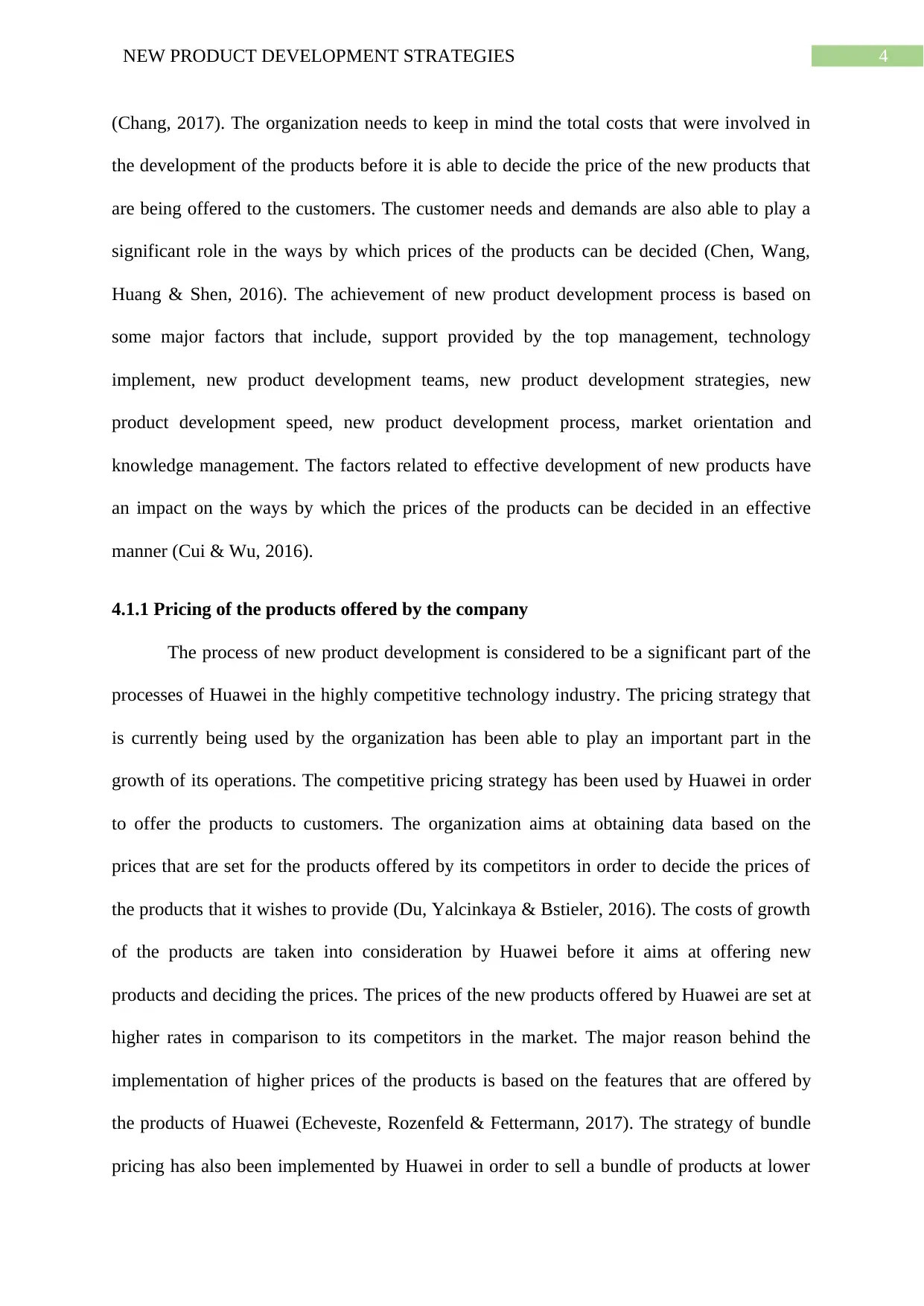
4NEW PRODUCT DEVELOPMENT STRATEGIES
(Chang, 2017). The organization needs to keep in mind the total costs that were involved in
the development of the products before it is able to decide the price of the new products that
are being offered to the customers. The customer needs and demands are also able to play a
significant role in the ways by which prices of the products can be decided (Chen, Wang,
Huang & Shen, 2016). The achievement of new product development process is based on
some major factors that include, support provided by the top management, technology
implement, new product development teams, new product development strategies, new
product development speed, new product development process, market orientation and
knowledge management. The factors related to effective development of new products have
an impact on the ways by which the prices of the products can be decided in an effective
manner (Cui & Wu, 2016).
4.1.1 Pricing of the products offered by the company
The process of new product development is considered to be a significant part of the
processes of Huawei in the highly competitive technology industry. The pricing strategy that
is currently being used by the organization has been able to play an important part in the
growth of its operations. The competitive pricing strategy has been used by Huawei in order
to offer the products to customers. The organization aims at obtaining data based on the
prices that are set for the products offered by its competitors in order to decide the prices of
the products that it wishes to provide (Du, Yalcinkaya & Bstieler, 2016). The costs of growth
of the products are taken into consideration by Huawei before it aims at offering new
products and deciding the prices. The prices of the new products offered by Huawei are set at
higher rates in comparison to its competitors in the market. The major reason behind the
implementation of higher prices of the products is based on the features that are offered by
the products of Huawei (Echeveste, Rozenfeld & Fettermann, 2017). The strategy of bundle
pricing has also been implemented by Huawei in order to sell a bundle of products at lower
(Chang, 2017). The organization needs to keep in mind the total costs that were involved in
the development of the products before it is able to decide the price of the new products that
are being offered to the customers. The customer needs and demands are also able to play a
significant role in the ways by which prices of the products can be decided (Chen, Wang,
Huang & Shen, 2016). The achievement of new product development process is based on
some major factors that include, support provided by the top management, technology
implement, new product development teams, new product development strategies, new
product development speed, new product development process, market orientation and
knowledge management. The factors related to effective development of new products have
an impact on the ways by which the prices of the products can be decided in an effective
manner (Cui & Wu, 2016).
4.1.1 Pricing of the products offered by the company
The process of new product development is considered to be a significant part of the
processes of Huawei in the highly competitive technology industry. The pricing strategy that
is currently being used by the organization has been able to play an important part in the
growth of its operations. The competitive pricing strategy has been used by Huawei in order
to offer the products to customers. The organization aims at obtaining data based on the
prices that are set for the products offered by its competitors in order to decide the prices of
the products that it wishes to provide (Du, Yalcinkaya & Bstieler, 2016). The costs of growth
of the products are taken into consideration by Huawei before it aims at offering new
products and deciding the prices. The prices of the new products offered by Huawei are set at
higher rates in comparison to its competitors in the market. The major reason behind the
implementation of higher prices of the products is based on the features that are offered by
the products of Huawei (Echeveste, Rozenfeld & Fettermann, 2017). The strategy of bundle
pricing has also been implemented by Huawei in order to sell a bundle of products at lower
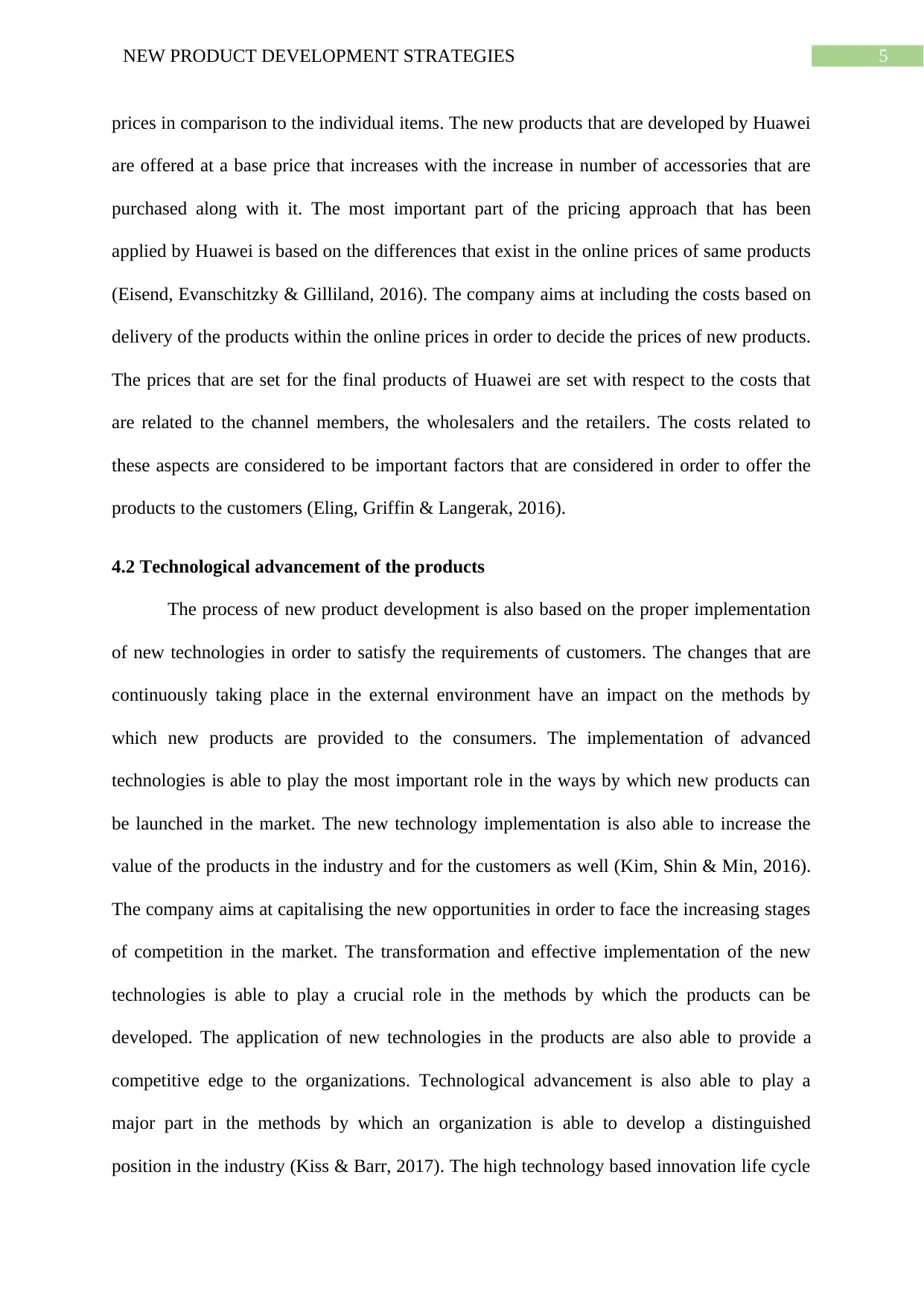
5NEW PRODUCT DEVELOPMENT STRATEGIES
prices in comparison to the individual items. The new products that are developed by Huawei
are offered at a base price that increases with the increase in number of accessories that are
purchased along with it. The most important part of the pricing approach that has been
applied by Huawei is based on the differences that exist in the online prices of same products
(Eisend, Evanschitzky & Gilliland, 2016). The company aims at including the costs based on
delivery of the products within the online prices in order to decide the prices of new products.
The prices that are set for the final products of Huawei are set with respect to the costs that
are related to the channel members, the wholesalers and the retailers. The costs related to
these aspects are considered to be important factors that are considered in order to offer the
products to the customers (Eling, Griffin & Langerak, 2016).
4.2 Technological advancement of the products
The process of new product development is also based on the proper implementation
of new technologies in order to satisfy the requirements of customers. The changes that are
continuously taking place in the external environment have an impact on the methods by
which new products are provided to the consumers. The implementation of advanced
technologies is able to play the most important role in the ways by which new products can
be launched in the market. The new technology implementation is also able to increase the
value of the products in the industry and for the customers as well (Kim, Shin & Min, 2016).
The company aims at capitalising the new opportunities in order to face the increasing stages
of competition in the market. The transformation and effective implementation of the new
technologies is able to play a crucial role in the methods by which the products can be
developed. The application of new technologies in the products are also able to provide a
competitive edge to the organizations. Technological advancement is also able to play a
major part in the methods by which an organization is able to develop a distinguished
position in the industry (Kiss & Barr, 2017). The high technology based innovation life cycle
prices in comparison to the individual items. The new products that are developed by Huawei
are offered at a base price that increases with the increase in number of accessories that are
purchased along with it. The most important part of the pricing approach that has been
applied by Huawei is based on the differences that exist in the online prices of same products
(Eisend, Evanschitzky & Gilliland, 2016). The company aims at including the costs based on
delivery of the products within the online prices in order to decide the prices of new products.
The prices that are set for the final products of Huawei are set with respect to the costs that
are related to the channel members, the wholesalers and the retailers. The costs related to
these aspects are considered to be important factors that are considered in order to offer the
products to the customers (Eling, Griffin & Langerak, 2016).
4.2 Technological advancement of the products
The process of new product development is also based on the proper implementation
of new technologies in order to satisfy the requirements of customers. The changes that are
continuously taking place in the external environment have an impact on the methods by
which new products are provided to the consumers. The implementation of advanced
technologies is able to play the most important role in the ways by which new products can
be launched in the market. The new technology implementation is also able to increase the
value of the products in the industry and for the customers as well (Kim, Shin & Min, 2016).
The company aims at capitalising the new opportunities in order to face the increasing stages
of competition in the market. The transformation and effective implementation of the new
technologies is able to play a crucial role in the methods by which the products can be
developed. The application of new technologies in the products are also able to provide a
competitive edge to the organizations. Technological advancement is also able to play a
major part in the methods by which an organization is able to develop a distinguished
position in the industry (Kiss & Barr, 2017). The high technology based innovation life cycle
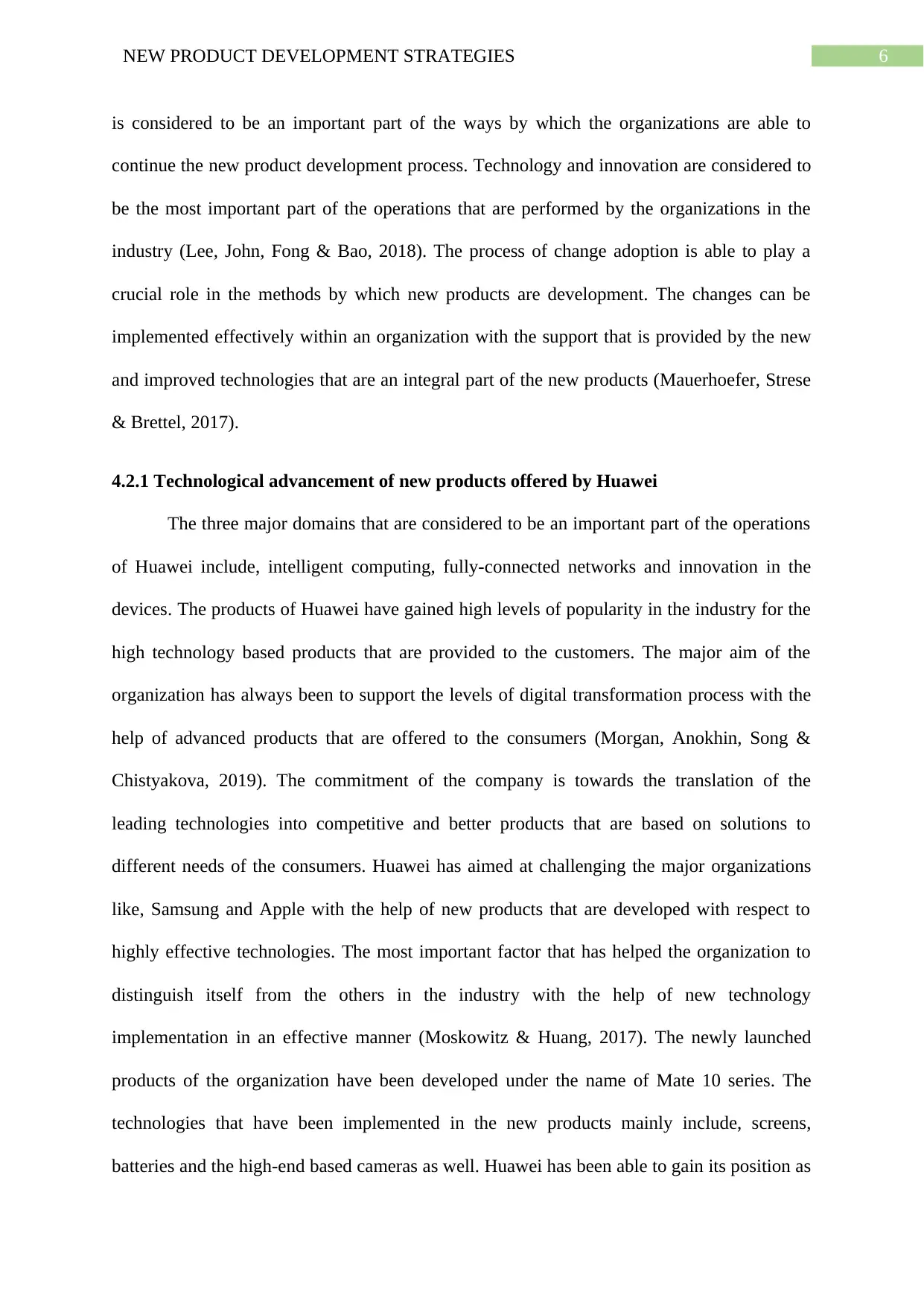
6NEW PRODUCT DEVELOPMENT STRATEGIES
is considered to be an important part of the ways by which the organizations are able to
continue the new product development process. Technology and innovation are considered to
be the most important part of the operations that are performed by the organizations in the
industry (Lee, John, Fong & Bao, 2018). The process of change adoption is able to play a
crucial role in the methods by which new products are development. The changes can be
implemented effectively within an organization with the support that is provided by the new
and improved technologies that are an integral part of the new products (Mauerhoefer, Strese
& Brettel, 2017).
4.2.1 Technological advancement of new products offered by Huawei
The three major domains that are considered to be an important part of the operations
of Huawei include, intelligent computing, fully-connected networks and innovation in the
devices. The products of Huawei have gained high levels of popularity in the industry for the
high technology based products that are provided to the customers. The major aim of the
organization has always been to support the levels of digital transformation process with the
help of advanced products that are offered to the consumers (Morgan, Anokhin, Song &
Chistyakova, 2019). The commitment of the company is towards the translation of the
leading technologies into competitive and better products that are based on solutions to
different needs of the consumers. Huawei has aimed at challenging the major organizations
like, Samsung and Apple with the help of new products that are developed with respect to
highly effective technologies. The most important factor that has helped the organization to
distinguish itself from the others in the industry with the help of new technology
implementation in an effective manner (Moskowitz & Huang, 2017). The newly launched
products of the organization have been developed under the name of Mate 10 series. The
technologies that have been implemented in the new products mainly include, screens,
batteries and the high-end based cameras as well. Huawei has been able to gain its position as
is considered to be an important part of the ways by which the organizations are able to
continue the new product development process. Technology and innovation are considered to
be the most important part of the operations that are performed by the organizations in the
industry (Lee, John, Fong & Bao, 2018). The process of change adoption is able to play a
crucial role in the methods by which new products are development. The changes can be
implemented effectively within an organization with the support that is provided by the new
and improved technologies that are an integral part of the new products (Mauerhoefer, Strese
& Brettel, 2017).
4.2.1 Technological advancement of new products offered by Huawei
The three major domains that are considered to be an important part of the operations
of Huawei include, intelligent computing, fully-connected networks and innovation in the
devices. The products of Huawei have gained high levels of popularity in the industry for the
high technology based products that are provided to the customers. The major aim of the
organization has always been to support the levels of digital transformation process with the
help of advanced products that are offered to the consumers (Morgan, Anokhin, Song &
Chistyakova, 2019). The commitment of the company is towards the translation of the
leading technologies into competitive and better products that are based on solutions to
different needs of the consumers. Huawei has aimed at challenging the major organizations
like, Samsung and Apple with the help of new products that are developed with respect to
highly effective technologies. The most important factor that has helped the organization to
distinguish itself from the others in the industry with the help of new technology
implementation in an effective manner (Moskowitz & Huang, 2017). The newly launched
products of the organization have been developed under the name of Mate 10 series. The
technologies that have been implemented in the new products mainly include, screens,
batteries and the high-end based cameras as well. Huawei has been able to gain its position as
Paraphrase This Document
Need a fresh take? Get an instant paraphrase of this document with our AI Paraphraser
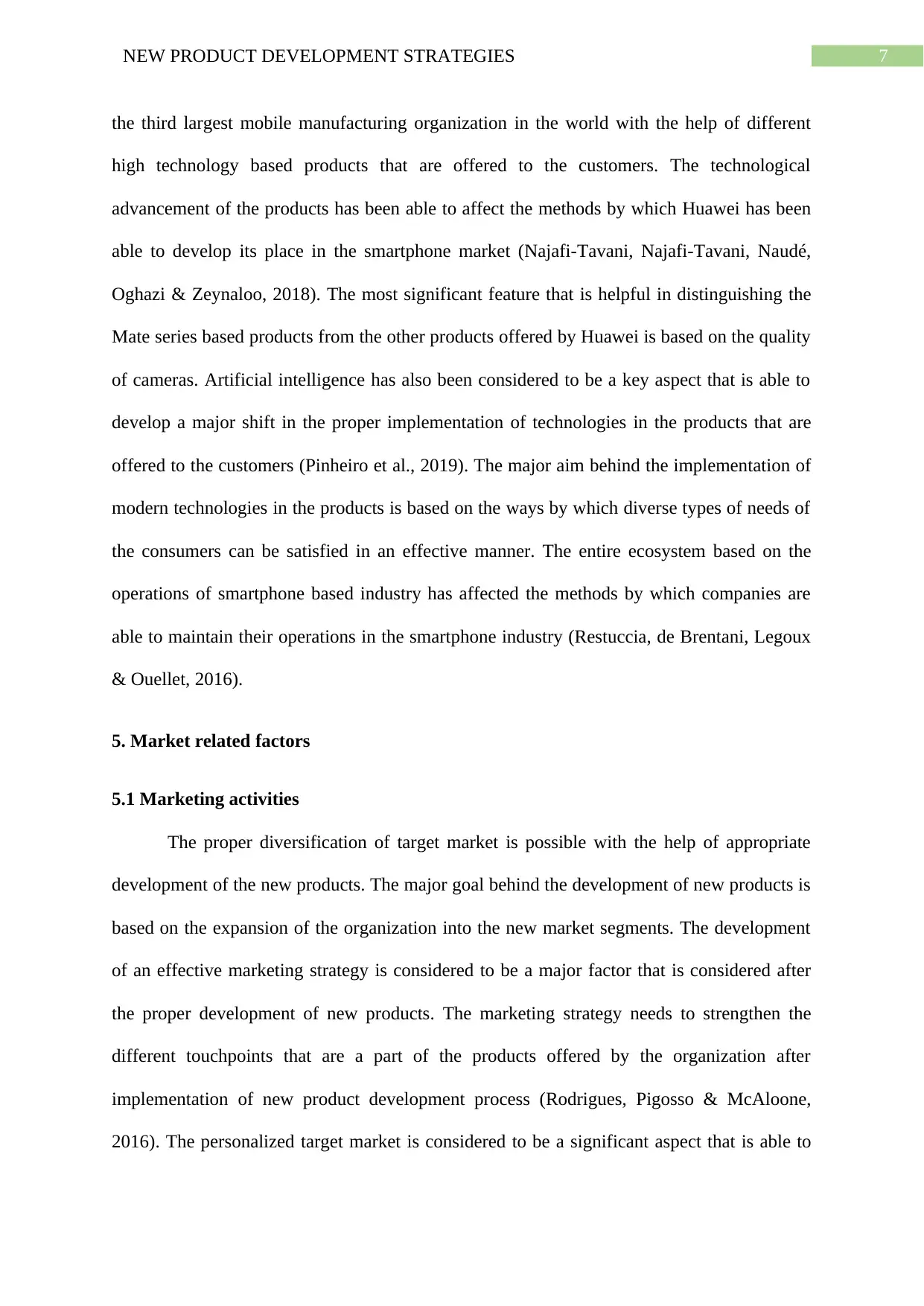
7NEW PRODUCT DEVELOPMENT STRATEGIES
the third largest mobile manufacturing organization in the world with the help of different
high technology based products that are offered to the customers. The technological
advancement of the products has been able to affect the methods by which Huawei has been
able to develop its place in the smartphone market (Najafi-Tavani, Najafi-Tavani, Naudé,
Oghazi & Zeynaloo, 2018). The most significant feature that is helpful in distinguishing the
Mate series based products from the other products offered by Huawei is based on the quality
of cameras. Artificial intelligence has also been considered to be a key aspect that is able to
develop a major shift in the proper implementation of technologies in the products that are
offered to the customers (Pinheiro et al., 2019). The major aim behind the implementation of
modern technologies in the products is based on the ways by which diverse types of needs of
the consumers can be satisfied in an effective manner. The entire ecosystem based on the
operations of smartphone based industry has affected the methods by which companies are
able to maintain their operations in the smartphone industry (Restuccia, de Brentani, Legoux
& Ouellet, 2016).
5. Market related factors
5.1 Marketing activities
The proper diversification of target market is possible with the help of appropriate
development of the new products. The major goal behind the development of new products is
based on the expansion of the organization into the new market segments. The development
of an effective marketing strategy is considered to be a major factor that is considered after
the proper development of new products. The marketing strategy needs to strengthen the
different touchpoints that are a part of the products offered by the organization after
implementation of new product development process (Rodrigues, Pigosso & McAloone,
2016). The personalized target market is considered to be a significant aspect that is able to
the third largest mobile manufacturing organization in the world with the help of different
high technology based products that are offered to the customers. The technological
advancement of the products has been able to affect the methods by which Huawei has been
able to develop its place in the smartphone market (Najafi-Tavani, Najafi-Tavani, Naudé,
Oghazi & Zeynaloo, 2018). The most significant feature that is helpful in distinguishing the
Mate series based products from the other products offered by Huawei is based on the quality
of cameras. Artificial intelligence has also been considered to be a key aspect that is able to
develop a major shift in the proper implementation of technologies in the products that are
offered to the customers (Pinheiro et al., 2019). The major aim behind the implementation of
modern technologies in the products is based on the ways by which diverse types of needs of
the consumers can be satisfied in an effective manner. The entire ecosystem based on the
operations of smartphone based industry has affected the methods by which companies are
able to maintain their operations in the smartphone industry (Restuccia, de Brentani, Legoux
& Ouellet, 2016).
5. Market related factors
5.1 Marketing activities
The proper diversification of target market is possible with the help of appropriate
development of the new products. The major goal behind the development of new products is
based on the expansion of the organization into the new market segments. The development
of an effective marketing strategy is considered to be a major factor that is considered after
the proper development of new products. The marketing strategy needs to strengthen the
different touchpoints that are a part of the products offered by the organization after
implementation of new product development process (Rodrigues, Pigosso & McAloone,
2016). The personalized target market is considered to be a significant aspect that is able to
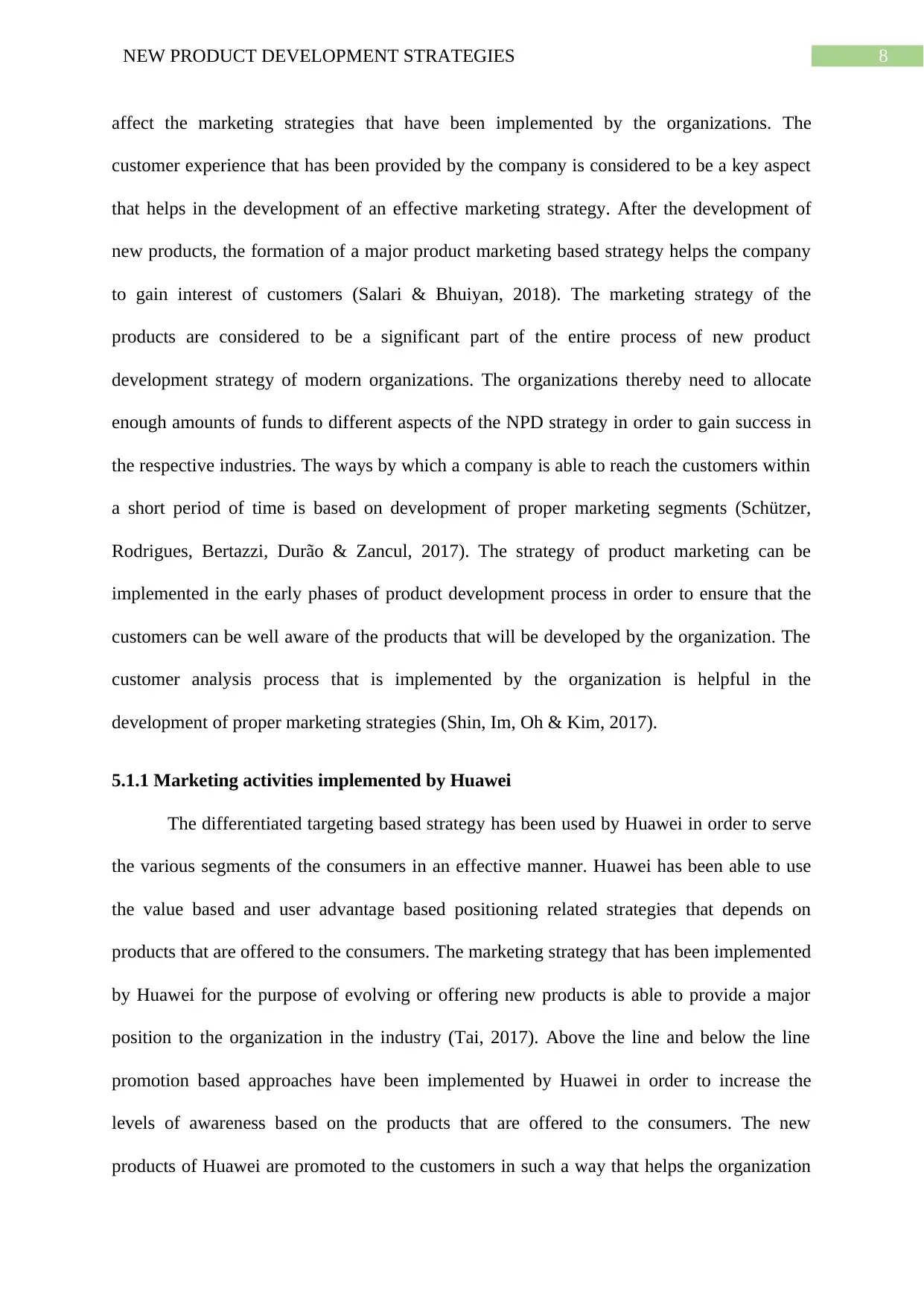
8NEW PRODUCT DEVELOPMENT STRATEGIES
affect the marketing strategies that have been implemented by the organizations. The
customer experience that has been provided by the company is considered to be a key aspect
that helps in the development of an effective marketing strategy. After the development of
new products, the formation of a major product marketing based strategy helps the company
to gain interest of customers (Salari & Bhuiyan, 2018). The marketing strategy of the
products are considered to be a significant part of the entire process of new product
development strategy of modern organizations. The organizations thereby need to allocate
enough amounts of funds to different aspects of the NPD strategy in order to gain success in
the respective industries. The ways by which a company is able to reach the customers within
a short period of time is based on development of proper marketing segments (Schützer,
Rodrigues, Bertazzi, Durão & Zancul, 2017). The strategy of product marketing can be
implemented in the early phases of product development process in order to ensure that the
customers can be well aware of the products that will be developed by the organization. The
customer analysis process that is implemented by the organization is helpful in the
development of proper marketing strategies (Shin, Im, Oh & Kim, 2017).
5.1.1 Marketing activities implemented by Huawei
The differentiated targeting based strategy has been used by Huawei in order to serve
the various segments of the consumers in an effective manner. Huawei has been able to use
the value based and user advantage based positioning related strategies that depends on
products that are offered to the consumers. The marketing strategy that has been implemented
by Huawei for the purpose of evolving or offering new products is able to provide a major
position to the organization in the industry (Tai, 2017). Above the line and below the line
promotion based approaches have been implemented by Huawei in order to increase the
levels of awareness based on the products that are offered to the consumers. The new
products of Huawei are promoted to the customers in such a way that helps the organization
affect the marketing strategies that have been implemented by the organizations. The
customer experience that has been provided by the company is considered to be a key aspect
that helps in the development of an effective marketing strategy. After the development of
new products, the formation of a major product marketing based strategy helps the company
to gain interest of customers (Salari & Bhuiyan, 2018). The marketing strategy of the
products are considered to be a significant part of the entire process of new product
development strategy of modern organizations. The organizations thereby need to allocate
enough amounts of funds to different aspects of the NPD strategy in order to gain success in
the respective industries. The ways by which a company is able to reach the customers within
a short period of time is based on development of proper marketing segments (Schützer,
Rodrigues, Bertazzi, Durão & Zancul, 2017). The strategy of product marketing can be
implemented in the early phases of product development process in order to ensure that the
customers can be well aware of the products that will be developed by the organization. The
customer analysis process that is implemented by the organization is helpful in the
development of proper marketing strategies (Shin, Im, Oh & Kim, 2017).
5.1.1 Marketing activities implemented by Huawei
The differentiated targeting based strategy has been used by Huawei in order to serve
the various segments of the consumers in an effective manner. Huawei has been able to use
the value based and user advantage based positioning related strategies that depends on
products that are offered to the consumers. The marketing strategy that has been implemented
by Huawei for the purpose of evolving or offering new products is able to provide a major
position to the organization in the industry (Tai, 2017). Above the line and below the line
promotion based approaches have been implemented by Huawei in order to increase the
levels of awareness based on the products that are offered to the consumers. The new
products of Huawei are promoted to the customers in such a way that helps the organization

9NEW PRODUCT DEVELOPMENT STRATEGIES
to define the unique selling propositions or USPs of the products that are provided to them
(Thomé, Scavarda, Ceryno & Remmen, 2016). The message content is crafted and evaluated
based on the messages that the company wishes to deliver to the customers. Promotional
strategies like the high profile based advertising strategies and direct selling process are able
to push the sales and levels of profitability of the organization as well. Information based on
the target market of the organization can be collected in such a manner that is able to provide
backing to Huawei in order to develop the new product development based marketing
strategies (Schützer, Rodrigues, Bertazzi, Durão & Zancul, 2017). The promotional options
of the organization will be taken into consideration in order to develop the strategies that are
implemented in different processes. The formation of marketing mix based strategies in an
effective manner is mainly dependent on the knowledge that Huawei has on potential
customers. The different strategies are considered to be highly effective for the organization
in order to identify various segments or customer profiles (Najafi-Tavani, Najafi-Tavani,
Naudé, Oghazi & Zeynaloo, 2018). The differentiation related competitive advantage based
strategy in order to introduce the new products in the industry. The premium positioning of
the products in the market is considered to be a significant aspect that is able to influence the
processes of the organization in a huge way (Morgan, Anokhin, Song & Chistyakova, 2019).
5.2 Levels of competitiveness in the market
The organizations can face major levels of competition built on the methods by which
new products are developed by the modern organizations. The three major types of
competitors of the organizations in the industry include, direct competitors, indirect
competitors and phantom competitors (Restuccia, de Brentani, Legoux & Ouellet, 2016). The
organizations need to face high levels of competition based on the implementation of proper
product management process. The new products that are offered by the organization have to
compete with the existing products that are already fulfilling the demands and needs of the
to define the unique selling propositions or USPs of the products that are provided to them
(Thomé, Scavarda, Ceryno & Remmen, 2016). The message content is crafted and evaluated
based on the messages that the company wishes to deliver to the customers. Promotional
strategies like the high profile based advertising strategies and direct selling process are able
to push the sales and levels of profitability of the organization as well. Information based on
the target market of the organization can be collected in such a manner that is able to provide
backing to Huawei in order to develop the new product development based marketing
strategies (Schützer, Rodrigues, Bertazzi, Durão & Zancul, 2017). The promotional options
of the organization will be taken into consideration in order to develop the strategies that are
implemented in different processes. The formation of marketing mix based strategies in an
effective manner is mainly dependent on the knowledge that Huawei has on potential
customers. The different strategies are considered to be highly effective for the organization
in order to identify various segments or customer profiles (Najafi-Tavani, Najafi-Tavani,
Naudé, Oghazi & Zeynaloo, 2018). The differentiation related competitive advantage based
strategy in order to introduce the new products in the industry. The premium positioning of
the products in the market is considered to be a significant aspect that is able to influence the
processes of the organization in a huge way (Morgan, Anokhin, Song & Chistyakova, 2019).
5.2 Levels of competitiveness in the market
The organizations can face major levels of competition built on the methods by which
new products are developed by the modern organizations. The three major types of
competitors of the organizations in the industry include, direct competitors, indirect
competitors and phantom competitors (Restuccia, de Brentani, Legoux & Ouellet, 2016). The
organizations need to face high levels of competition based on the implementation of proper
product management process. The new products that are offered by the organization have to
compete with the existing products that are already fulfilling the demands and needs of the
Secure Best Marks with AI Grader
Need help grading? Try our AI Grader for instant feedback on your assignments.
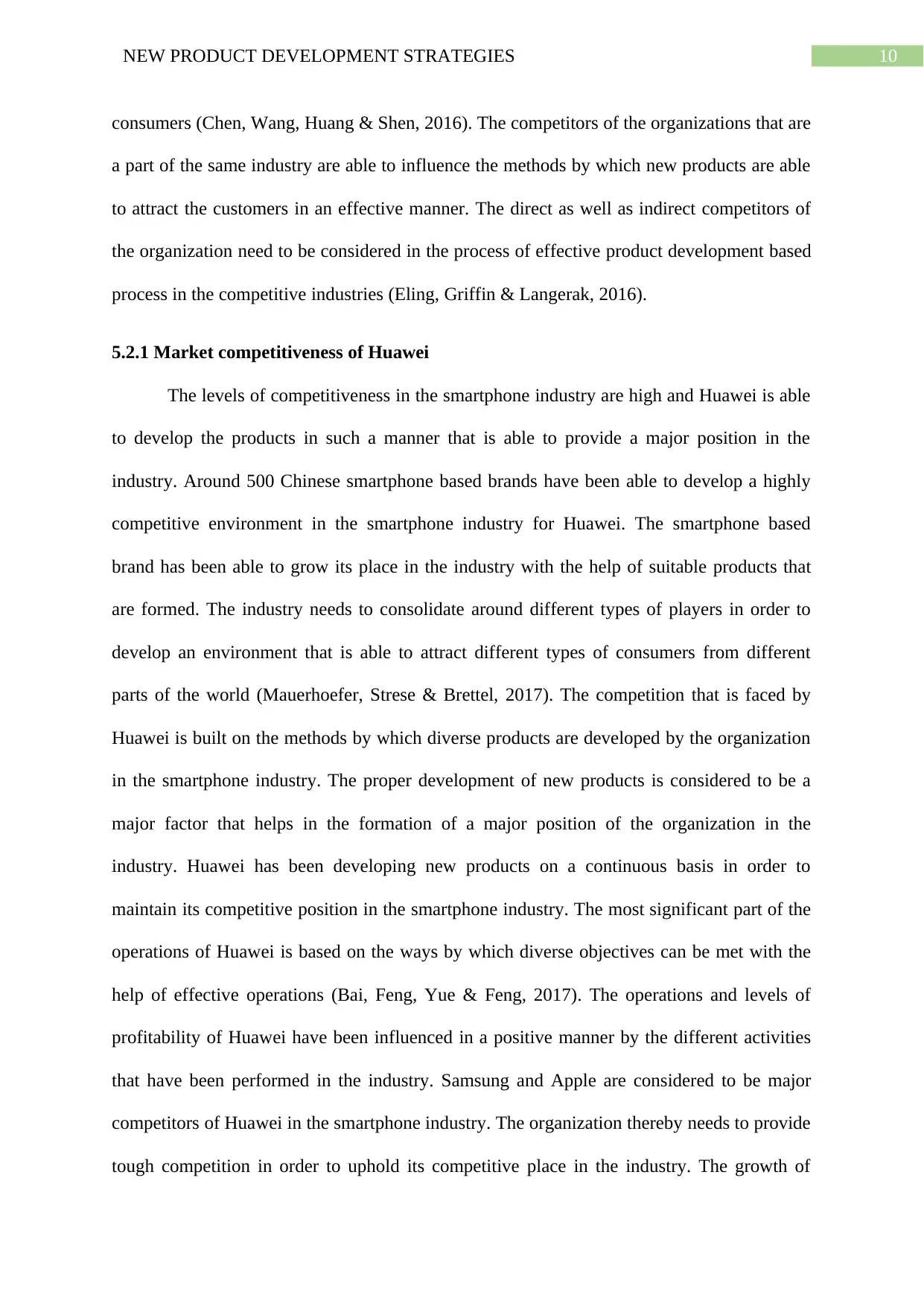
10NEW PRODUCT DEVELOPMENT STRATEGIES
consumers (Chen, Wang, Huang & Shen, 2016). The competitors of the organizations that are
a part of the same industry are able to influence the methods by which new products are able
to attract the customers in an effective manner. The direct as well as indirect competitors of
the organization need to be considered in the process of effective product development based
process in the competitive industries (Eling, Griffin & Langerak, 2016).
5.2.1 Market competitiveness of Huawei
The levels of competitiveness in the smartphone industry are high and Huawei is able
to develop the products in such a manner that is able to provide a major position in the
industry. Around 500 Chinese smartphone based brands have been able to develop a highly
competitive environment in the smartphone industry for Huawei. The smartphone based
brand has been able to grow its place in the industry with the help of suitable products that
are formed. The industry needs to consolidate around different types of players in order to
develop an environment that is able to attract different types of consumers from different
parts of the world (Mauerhoefer, Strese & Brettel, 2017). The competition that is faced by
Huawei is built on the methods by which diverse products are developed by the organization
in the smartphone industry. The proper development of new products is considered to be a
major factor that helps in the formation of a major position of the organization in the
industry. Huawei has been developing new products on a continuous basis in order to
maintain its competitive position in the smartphone industry. The most significant part of the
operations of Huawei is based on the ways by which diverse objectives can be met with the
help of effective operations (Bai, Feng, Yue & Feng, 2017). The operations and levels of
profitability of Huawei have been influenced in a positive manner by the different activities
that have been performed in the industry. Samsung and Apple are considered to be major
competitors of Huawei in the smartphone industry. The organization thereby needs to provide
tough competition in order to uphold its competitive place in the industry. The growth of
consumers (Chen, Wang, Huang & Shen, 2016). The competitors of the organizations that are
a part of the same industry are able to influence the methods by which new products are able
to attract the customers in an effective manner. The direct as well as indirect competitors of
the organization need to be considered in the process of effective product development based
process in the competitive industries (Eling, Griffin & Langerak, 2016).
5.2.1 Market competitiveness of Huawei
The levels of competitiveness in the smartphone industry are high and Huawei is able
to develop the products in such a manner that is able to provide a major position in the
industry. Around 500 Chinese smartphone based brands have been able to develop a highly
competitive environment in the smartphone industry for Huawei. The smartphone based
brand has been able to grow its place in the industry with the help of suitable products that
are formed. The industry needs to consolidate around different types of players in order to
develop an environment that is able to attract different types of consumers from different
parts of the world (Mauerhoefer, Strese & Brettel, 2017). The competition that is faced by
Huawei is built on the methods by which diverse products are developed by the organization
in the smartphone industry. The proper development of new products is considered to be a
major factor that helps in the formation of a major position of the organization in the
industry. Huawei has been developing new products on a continuous basis in order to
maintain its competitive position in the smartphone industry. The most significant part of the
operations of Huawei is based on the ways by which diverse objectives can be met with the
help of effective operations (Bai, Feng, Yue & Feng, 2017). The operations and levels of
profitability of Huawei have been influenced in a positive manner by the different activities
that have been performed in the industry. Samsung and Apple are considered to be major
competitors of Huawei in the smartphone industry. The organization thereby needs to provide
tough competition in order to uphold its competitive place in the industry. The growth of
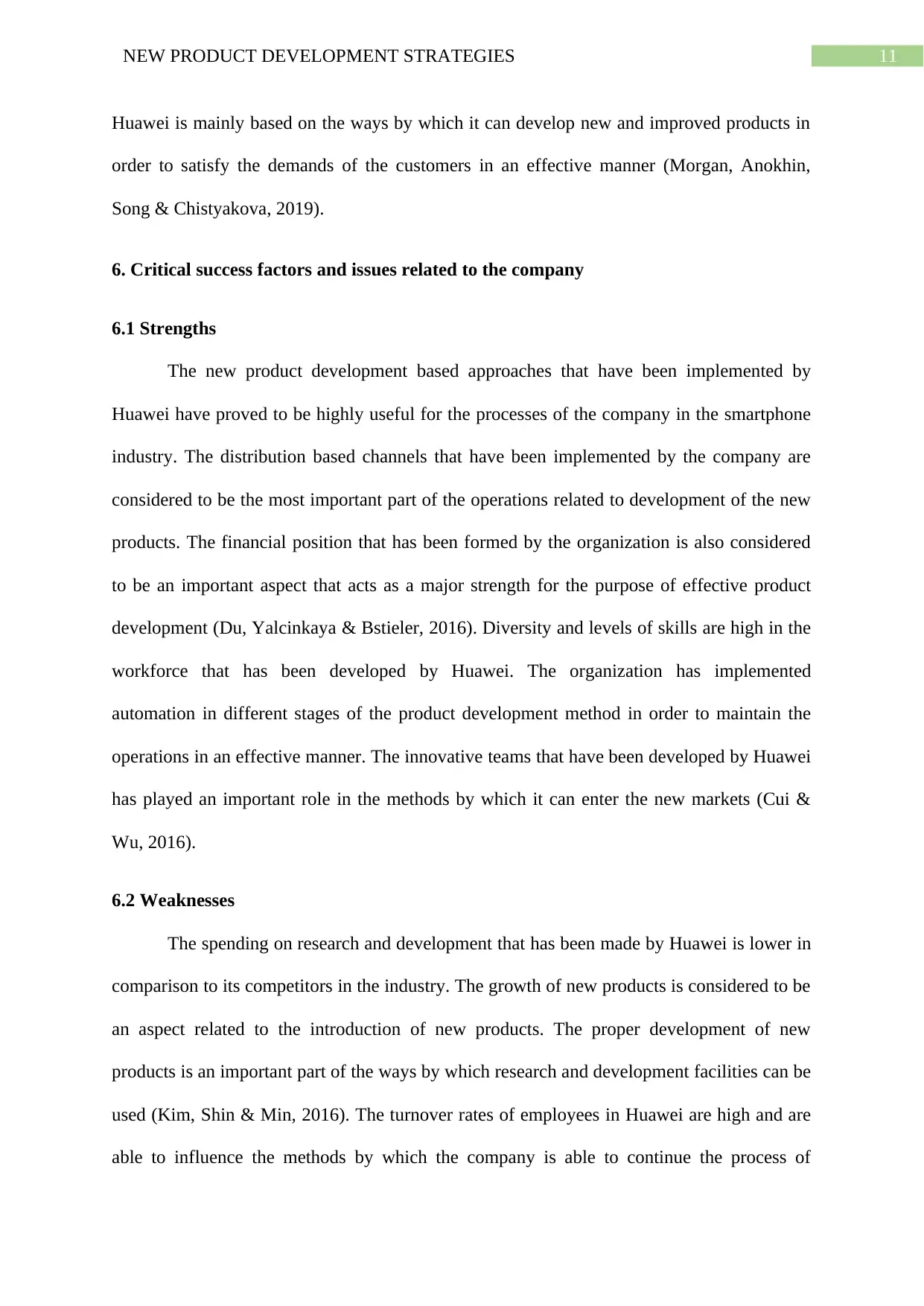
11NEW PRODUCT DEVELOPMENT STRATEGIES
Huawei is mainly based on the ways by which it can develop new and improved products in
order to satisfy the demands of the customers in an effective manner (Morgan, Anokhin,
Song & Chistyakova, 2019).
6. Critical success factors and issues related to the company
6.1 Strengths
The new product development based approaches that have been implemented by
Huawei have proved to be highly useful for the processes of the company in the smartphone
industry. The distribution based channels that have been implemented by the company are
considered to be the most important part of the operations related to development of the new
products. The financial position that has been formed by the organization is also considered
to be an important aspect that acts as a major strength for the purpose of effective product
development (Du, Yalcinkaya & Bstieler, 2016). Diversity and levels of skills are high in the
workforce that has been developed by Huawei. The organization has implemented
automation in different stages of the product development method in order to maintain the
operations in an effective manner. The innovative teams that have been developed by Huawei
has played an important role in the methods by which it can enter the new markets (Cui &
Wu, 2016).
6.2 Weaknesses
The spending on research and development that has been made by Huawei is lower in
comparison to its competitors in the industry. The growth of new products is considered to be
an aspect related to the introduction of new products. The proper development of new
products is an important part of the ways by which research and development facilities can be
used (Kim, Shin & Min, 2016). The turnover rates of employees in Huawei are high and are
able to influence the methods by which the company is able to continue the process of
Huawei is mainly based on the ways by which it can develop new and improved products in
order to satisfy the demands of the customers in an effective manner (Morgan, Anokhin,
Song & Chistyakova, 2019).
6. Critical success factors and issues related to the company
6.1 Strengths
The new product development based approaches that have been implemented by
Huawei have proved to be highly useful for the processes of the company in the smartphone
industry. The distribution based channels that have been implemented by the company are
considered to be the most important part of the operations related to development of the new
products. The financial position that has been formed by the organization is also considered
to be an important aspect that acts as a major strength for the purpose of effective product
development (Du, Yalcinkaya & Bstieler, 2016). Diversity and levels of skills are high in the
workforce that has been developed by Huawei. The organization has implemented
automation in different stages of the product development method in order to maintain the
operations in an effective manner. The innovative teams that have been developed by Huawei
has played an important role in the methods by which it can enter the new markets (Cui &
Wu, 2016).
6.2 Weaknesses
The spending on research and development that has been made by Huawei is lower in
comparison to its competitors in the industry. The growth of new products is considered to be
an aspect related to the introduction of new products. The proper development of new
products is an important part of the ways by which research and development facilities can be
used (Kim, Shin & Min, 2016). The turnover rates of employees in Huawei are high and are
able to influence the methods by which the company is able to continue the process of
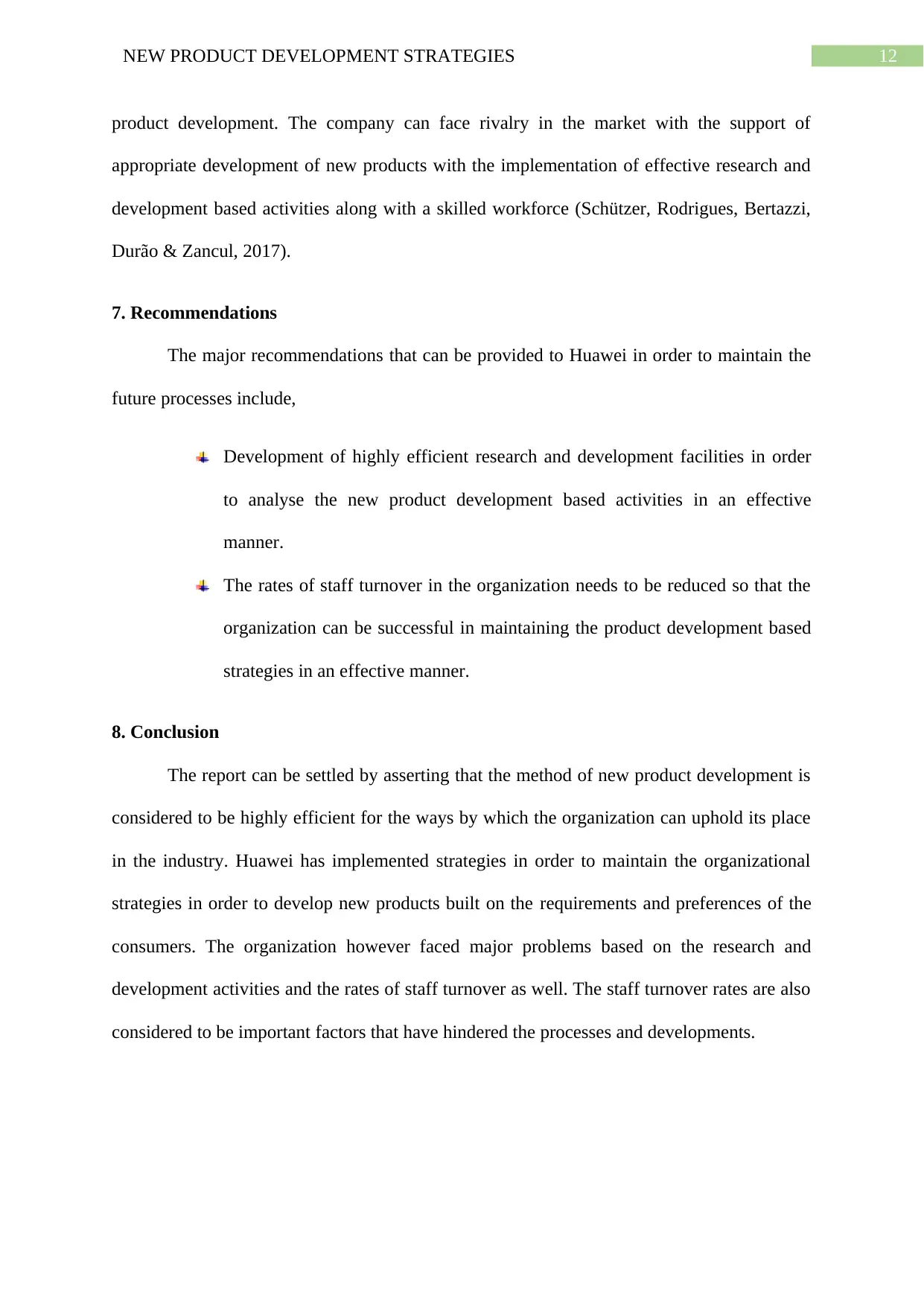
12NEW PRODUCT DEVELOPMENT STRATEGIES
product development. The company can face rivalry in the market with the support of
appropriate development of new products with the implementation of effective research and
development based activities along with a skilled workforce (Schützer, Rodrigues, Bertazzi,
Durão & Zancul, 2017).
7. Recommendations
The major recommendations that can be provided to Huawei in order to maintain the
future processes include,
Development of highly efficient research and development facilities in order
to analyse the new product development based activities in an effective
manner.
The rates of staff turnover in the organization needs to be reduced so that the
organization can be successful in maintaining the product development based
strategies in an effective manner.
8. Conclusion
The report can be settled by asserting that the method of new product development is
considered to be highly efficient for the ways by which the organization can uphold its place
in the industry. Huawei has implemented strategies in order to maintain the organizational
strategies in order to develop new products built on the requirements and preferences of the
consumers. The organization however faced major problems based on the research and
development activities and the rates of staff turnover as well. The staff turnover rates are also
considered to be important factors that have hindered the processes and developments.
product development. The company can face rivalry in the market with the support of
appropriate development of new products with the implementation of effective research and
development based activities along with a skilled workforce (Schützer, Rodrigues, Bertazzi,
Durão & Zancul, 2017).
7. Recommendations
The major recommendations that can be provided to Huawei in order to maintain the
future processes include,
Development of highly efficient research and development facilities in order
to analyse the new product development based activities in an effective
manner.
The rates of staff turnover in the organization needs to be reduced so that the
organization can be successful in maintaining the product development based
strategies in an effective manner.
8. Conclusion
The report can be settled by asserting that the method of new product development is
considered to be highly efficient for the ways by which the organization can uphold its place
in the industry. Huawei has implemented strategies in order to maintain the organizational
strategies in order to develop new products built on the requirements and preferences of the
consumers. The organization however faced major problems based on the research and
development activities and the rates of staff turnover as well. The staff turnover rates are also
considered to be important factors that have hindered the processes and developments.
Paraphrase This Document
Need a fresh take? Get an instant paraphrase of this document with our AI Paraphraser
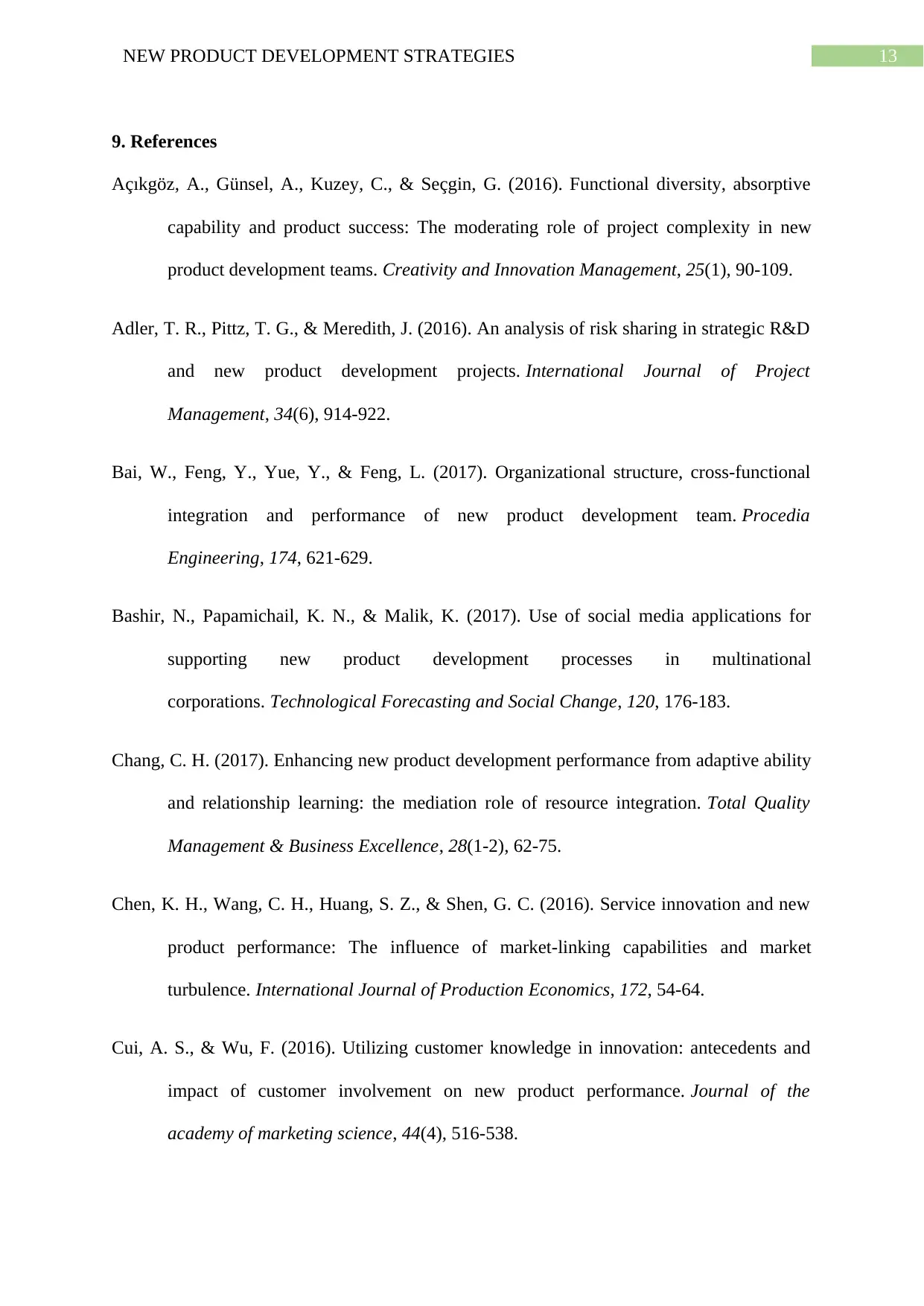
13NEW PRODUCT DEVELOPMENT STRATEGIES
9. References
Açıkgöz, A., Günsel, A., Kuzey, C., & Seçgin, G. (2016). Functional diversity, absorptive
capability and product success: The moderating role of project complexity in new
product development teams. Creativity and Innovation Management, 25(1), 90-109.
Adler, T. R., Pittz, T. G., & Meredith, J. (2016). An analysis of risk sharing in strategic R&D
and new product development projects. International Journal of Project
Management, 34(6), 914-922.
Bai, W., Feng, Y., Yue, Y., & Feng, L. (2017). Organizational structure, cross-functional
integration and performance of new product development team. Procedia
Engineering, 174, 621-629.
Bashir, N., Papamichail, K. N., & Malik, K. (2017). Use of social media applications for
supporting new product development processes in multinational
corporations. Technological Forecasting and Social Change, 120, 176-183.
Chang, C. H. (2017). Enhancing new product development performance from adaptive ability
and relationship learning: the mediation role of resource integration. Total Quality
Management & Business Excellence, 28(1-2), 62-75.
Chen, K. H., Wang, C. H., Huang, S. Z., & Shen, G. C. (2016). Service innovation and new
product performance: The influence of market-linking capabilities and market
turbulence. International Journal of Production Economics, 172, 54-64.
Cui, A. S., & Wu, F. (2016). Utilizing customer knowledge in innovation: antecedents and
impact of customer involvement on new product performance. Journal of the
academy of marketing science, 44(4), 516-538.
9. References
Açıkgöz, A., Günsel, A., Kuzey, C., & Seçgin, G. (2016). Functional diversity, absorptive
capability and product success: The moderating role of project complexity in new
product development teams. Creativity and Innovation Management, 25(1), 90-109.
Adler, T. R., Pittz, T. G., & Meredith, J. (2016). An analysis of risk sharing in strategic R&D
and new product development projects. International Journal of Project
Management, 34(6), 914-922.
Bai, W., Feng, Y., Yue, Y., & Feng, L. (2017). Organizational structure, cross-functional
integration and performance of new product development team. Procedia
Engineering, 174, 621-629.
Bashir, N., Papamichail, K. N., & Malik, K. (2017). Use of social media applications for
supporting new product development processes in multinational
corporations. Technological Forecasting and Social Change, 120, 176-183.
Chang, C. H. (2017). Enhancing new product development performance from adaptive ability
and relationship learning: the mediation role of resource integration. Total Quality
Management & Business Excellence, 28(1-2), 62-75.
Chen, K. H., Wang, C. H., Huang, S. Z., & Shen, G. C. (2016). Service innovation and new
product performance: The influence of market-linking capabilities and market
turbulence. International Journal of Production Economics, 172, 54-64.
Cui, A. S., & Wu, F. (2016). Utilizing customer knowledge in innovation: antecedents and
impact of customer involvement on new product performance. Journal of the
academy of marketing science, 44(4), 516-538.
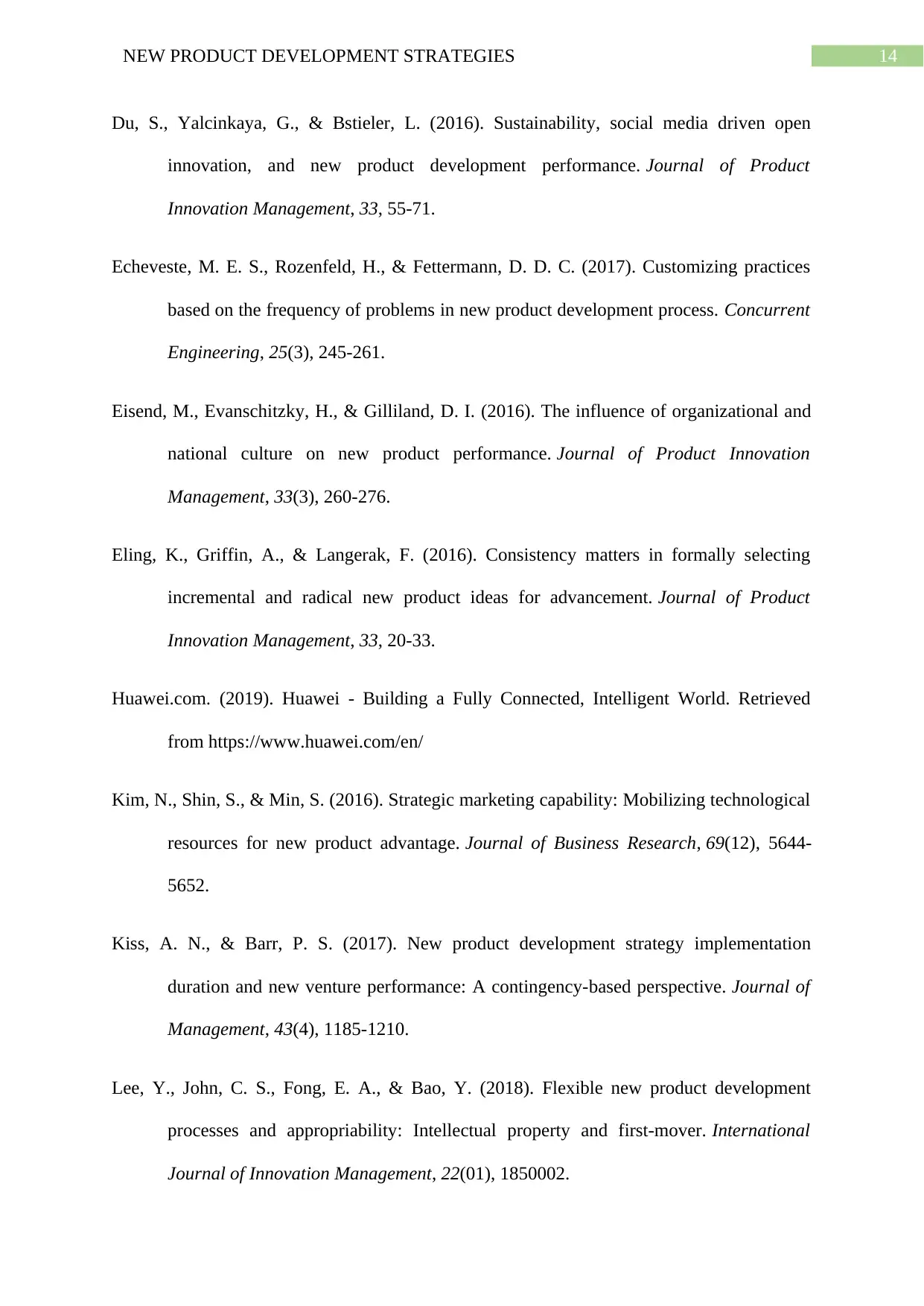
14NEW PRODUCT DEVELOPMENT STRATEGIES
Du, S., Yalcinkaya, G., & Bstieler, L. (2016). Sustainability, social media driven open
innovation, and new product development performance. Journal of Product
Innovation Management, 33, 55-71.
Echeveste, M. E. S., Rozenfeld, H., & Fettermann, D. D. C. (2017). Customizing practices
based on the frequency of problems in new product development process. Concurrent
Engineering, 25(3), 245-261.
Eisend, M., Evanschitzky, H., & Gilliland, D. I. (2016). The influence of organizational and
national culture on new product performance. Journal of Product Innovation
Management, 33(3), 260-276.
Eling, K., Griffin, A., & Langerak, F. (2016). Consistency matters in formally selecting
incremental and radical new product ideas for advancement. Journal of Product
Innovation Management, 33, 20-33.
Huawei.com. (2019). Huawei - Building a Fully Connected, Intelligent World. Retrieved
from https://www.huawei.com/en/
Kim, N., Shin, S., & Min, S. (2016). Strategic marketing capability: Mobilizing technological
resources for new product advantage. Journal of Business Research, 69(12), 5644-
5652.
Kiss, A. N., & Barr, P. S. (2017). New product development strategy implementation
duration and new venture performance: A contingency-based perspective. Journal of
Management, 43(4), 1185-1210.
Lee, Y., John, C. S., Fong, E. A., & Bao, Y. (2018). Flexible new product development
processes and appropriability: Intellectual property and first-mover. International
Journal of Innovation Management, 22(01), 1850002.
Du, S., Yalcinkaya, G., & Bstieler, L. (2016). Sustainability, social media driven open
innovation, and new product development performance. Journal of Product
Innovation Management, 33, 55-71.
Echeveste, M. E. S., Rozenfeld, H., & Fettermann, D. D. C. (2017). Customizing practices
based on the frequency of problems in new product development process. Concurrent
Engineering, 25(3), 245-261.
Eisend, M., Evanschitzky, H., & Gilliland, D. I. (2016). The influence of organizational and
national culture on new product performance. Journal of Product Innovation
Management, 33(3), 260-276.
Eling, K., Griffin, A., & Langerak, F. (2016). Consistency matters in formally selecting
incremental and radical new product ideas for advancement. Journal of Product
Innovation Management, 33, 20-33.
Huawei.com. (2019). Huawei - Building a Fully Connected, Intelligent World. Retrieved
from https://www.huawei.com/en/
Kim, N., Shin, S., & Min, S. (2016). Strategic marketing capability: Mobilizing technological
resources for new product advantage. Journal of Business Research, 69(12), 5644-
5652.
Kiss, A. N., & Barr, P. S. (2017). New product development strategy implementation
duration and new venture performance: A contingency-based perspective. Journal of
Management, 43(4), 1185-1210.
Lee, Y., John, C. S., Fong, E. A., & Bao, Y. (2018). Flexible new product development
processes and appropriability: Intellectual property and first-mover. International
Journal of Innovation Management, 22(01), 1850002.
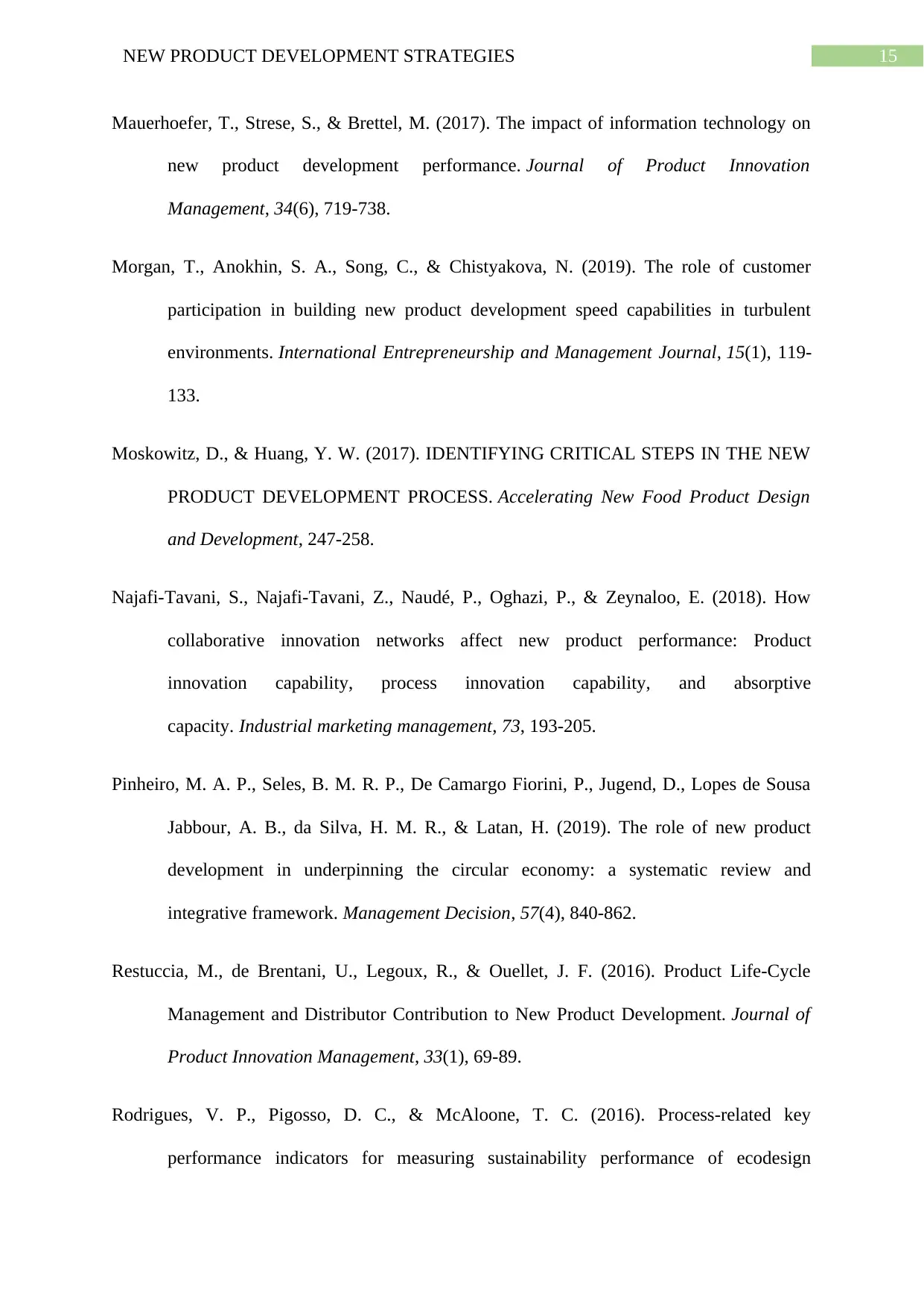
15NEW PRODUCT DEVELOPMENT STRATEGIES
Mauerhoefer, T., Strese, S., & Brettel, M. (2017). The impact of information technology on
new product development performance. Journal of Product Innovation
Management, 34(6), 719-738.
Morgan, T., Anokhin, S. A., Song, C., & Chistyakova, N. (2019). The role of customer
participation in building new product development speed capabilities in turbulent
environments. International Entrepreneurship and Management Journal, 15(1), 119-
133.
Moskowitz, D., & Huang, Y. W. (2017). IDENTIFYING CRITICAL STEPS IN THE NEW
PRODUCT DEVELOPMENT PROCESS. Accelerating New Food Product Design
and Development, 247-258.
Najafi-Tavani, S., Najafi-Tavani, Z., Naudé, P., Oghazi, P., & Zeynaloo, E. (2018). How
collaborative innovation networks affect new product performance: Product
innovation capability, process innovation capability, and absorptive
capacity. Industrial marketing management, 73, 193-205.
Pinheiro, M. A. P., Seles, B. M. R. P., De Camargo Fiorini, P., Jugend, D., Lopes de Sousa
Jabbour, A. B., da Silva, H. M. R., & Latan, H. (2019). The role of new product
development in underpinning the circular economy: a systematic review and
integrative framework. Management Decision, 57(4), 840-862.
Restuccia, M., de Brentani, U., Legoux, R., & Ouellet, J. F. (2016). Product Life‐Cycle
Management and Distributor Contribution to New Product Development. Journal of
Product Innovation Management, 33(1), 69-89.
Rodrigues, V. P., Pigosso, D. C., & McAloone, T. C. (2016). Process-related key
performance indicators for measuring sustainability performance of ecodesign
Mauerhoefer, T., Strese, S., & Brettel, M. (2017). The impact of information technology on
new product development performance. Journal of Product Innovation
Management, 34(6), 719-738.
Morgan, T., Anokhin, S. A., Song, C., & Chistyakova, N. (2019). The role of customer
participation in building new product development speed capabilities in turbulent
environments. International Entrepreneurship and Management Journal, 15(1), 119-
133.
Moskowitz, D., & Huang, Y. W. (2017). IDENTIFYING CRITICAL STEPS IN THE NEW
PRODUCT DEVELOPMENT PROCESS. Accelerating New Food Product Design
and Development, 247-258.
Najafi-Tavani, S., Najafi-Tavani, Z., Naudé, P., Oghazi, P., & Zeynaloo, E. (2018). How
collaborative innovation networks affect new product performance: Product
innovation capability, process innovation capability, and absorptive
capacity. Industrial marketing management, 73, 193-205.
Pinheiro, M. A. P., Seles, B. M. R. P., De Camargo Fiorini, P., Jugend, D., Lopes de Sousa
Jabbour, A. B., da Silva, H. M. R., & Latan, H. (2019). The role of new product
development in underpinning the circular economy: a systematic review and
integrative framework. Management Decision, 57(4), 840-862.
Restuccia, M., de Brentani, U., Legoux, R., & Ouellet, J. F. (2016). Product Life‐Cycle
Management and Distributor Contribution to New Product Development. Journal of
Product Innovation Management, 33(1), 69-89.
Rodrigues, V. P., Pigosso, D. C., & McAloone, T. C. (2016). Process-related key
performance indicators for measuring sustainability performance of ecodesign
Secure Best Marks with AI Grader
Need help grading? Try our AI Grader for instant feedback on your assignments.
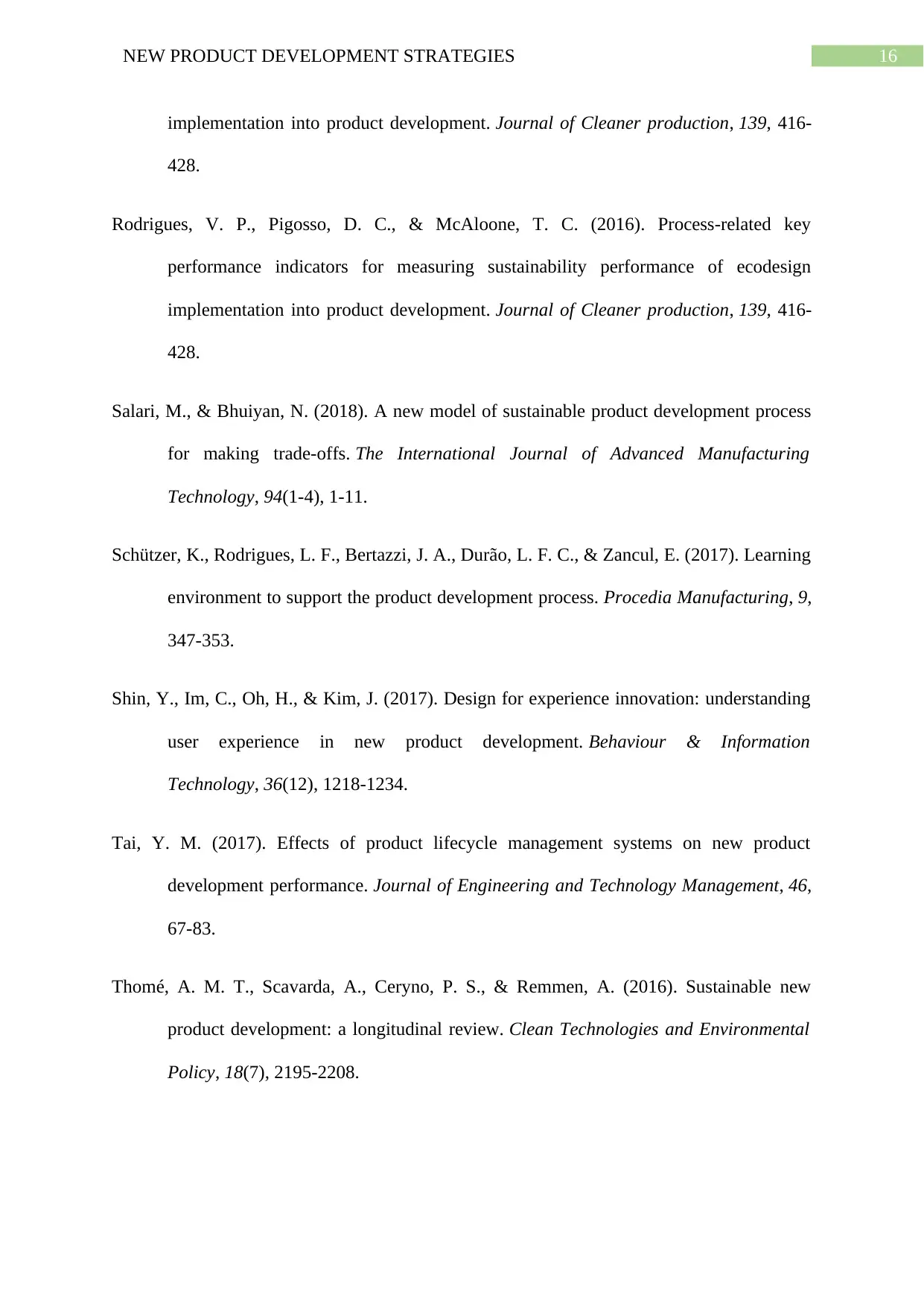
16NEW PRODUCT DEVELOPMENT STRATEGIES
implementation into product development. Journal of Cleaner production, 139, 416-
428.
Rodrigues, V. P., Pigosso, D. C., & McAloone, T. C. (2016). Process-related key
performance indicators for measuring sustainability performance of ecodesign
implementation into product development. Journal of Cleaner production, 139, 416-
428.
Salari, M., & Bhuiyan, N. (2018). A new model of sustainable product development process
for making trade-offs. The International Journal of Advanced Manufacturing
Technology, 94(1-4), 1-11.
Schützer, K., Rodrigues, L. F., Bertazzi, J. A., Durão, L. F. C., & Zancul, E. (2017). Learning
environment to support the product development process. Procedia Manufacturing, 9,
347-353.
Shin, Y., Im, C., Oh, H., & Kim, J. (2017). Design for experience innovation: understanding
user experience in new product development. Behaviour & Information
Technology, 36(12), 1218-1234.
Tai, Y. M. (2017). Effects of product lifecycle management systems on new product
development performance. Journal of Engineering and Technology Management, 46,
67-83.
Thomé, A. M. T., Scavarda, A., Ceryno, P. S., & Remmen, A. (2016). Sustainable new
product development: a longitudinal review. Clean Technologies and Environmental
Policy, 18(7), 2195-2208.
implementation into product development. Journal of Cleaner production, 139, 416-
428.
Rodrigues, V. P., Pigosso, D. C., & McAloone, T. C. (2016). Process-related key
performance indicators for measuring sustainability performance of ecodesign
implementation into product development. Journal of Cleaner production, 139, 416-
428.
Salari, M., & Bhuiyan, N. (2018). A new model of sustainable product development process
for making trade-offs. The International Journal of Advanced Manufacturing
Technology, 94(1-4), 1-11.
Schützer, K., Rodrigues, L. F., Bertazzi, J. A., Durão, L. F. C., & Zancul, E. (2017). Learning
environment to support the product development process. Procedia Manufacturing, 9,
347-353.
Shin, Y., Im, C., Oh, H., & Kim, J. (2017). Design for experience innovation: understanding
user experience in new product development. Behaviour & Information
Technology, 36(12), 1218-1234.
Tai, Y. M. (2017). Effects of product lifecycle management systems on new product
development performance. Journal of Engineering and Technology Management, 46,
67-83.
Thomé, A. M. T., Scavarda, A., Ceryno, P. S., & Remmen, A. (2016). Sustainable new
product development: a longitudinal review. Clean Technologies and Environmental
Policy, 18(7), 2195-2208.
1 out of 17
Related Documents
Your All-in-One AI-Powered Toolkit for Academic Success.
+13062052269
info@desklib.com
Available 24*7 on WhatsApp / Email
![[object Object]](/_next/static/media/star-bottom.7253800d.svg)
Unlock your academic potential
© 2024 | Zucol Services PVT LTD | All rights reserved.





